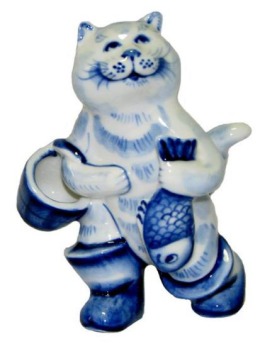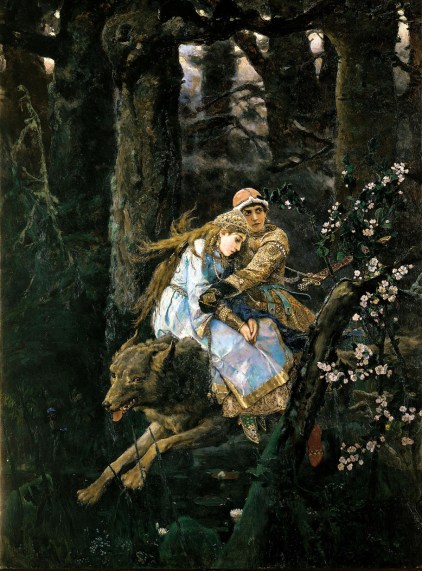Many times have I heard people calling matryoshka dolls babushkas. Thing is that, matryoshkas are matryoshkas… they’re not babushkas (grandma in Russian). People may not know its correct name, but they DO know that it’s the most famous Russian souvenir. Ah, matryoshka dolls, who doesn’t wish to buy one when traveling to Russia? It’s definitely a must-buy for every foreign tourist. Sadly, it is my duty to inform you that there are many alternatives to matryoshkas!
Today I will introduce one alternative: gzhel.
These porcelain crafts under the name of gzhel emerged in the 14th century in the small town of Gzhel, not too far away from Moscow. Funny, hah. Basically, this town’s major industry was pottery. For centuries, they supplied the empire with handcrafted clay, tiles, bricks, and pottery. Soon, gzhel, a blue patterned style of ceramics, became a traditional Russian craft. Russians love these porcelain figurines, glazed solid white with distinctive blue designs. It is a very nifty painting style, using floral and geometric ornament motifs. I even have some at my home!
Most of the time, gzhel artists find their inspiration in Russian folk tales. The following is one example (excuse me if I go off topic, but I actually believe this is topic related):

This is a scene from a very well known folk tale, Ivan Tsarevitch and the Grey Wolf. There is even a famous painting by Viktor Vasnetsov, also depicting this scene from the folk tale.

I saw this beautiful painting in the Tretyakov Gallery in Moscow. It was stunning, like all the other paintings of Vasnetsov, where folk culture meets art. In his painting, Ivan and Yelena the Beautiful attempt to escape a chase, galloping through the dim forest. Ivan Tsarevitch, or Ivan the Prince, is actually one of the main protagonists of Russian folklore. He appears in a number of different tales, always a hero. He is young and brave, and you may find him struggling against Koschei the Immortal, an evil character from the story, The Death of Koschei the Deathless, or you may find him chasing a mythical bird, a prominent figure in many folk stories. This bird, called the fire-bird, is the main object of desire of all heroes, including Ivan Tsarevitch. I could never really understand what was so special about the bird that made them want it so much. It’s what they always seek… in pretty much every folk tale. It turns out that this bird has golden feathers, so light and pure that one feather is enough to light an entire dark room. Feathers so shiny, able to leave a person sightless. Its feathers shine with gold and silver, wings like flames, eyes sparkly like crystal. Anyhow, as a request from his father, Ivan was to capture and deliver the fire-bird back to his father’s castle. It is during his journey that he meets the grey wolf and Yelena.

Here too, we see Ivan Tsarevitch. In this painting, he is flying with his captured trophy, the fire-bird inside her golden cage. If you enlarge the image you’ll be able to see this awesome bird in better detail! You may also be wondering what’s that thing he’s on… well it’s a flying carpet. Legend goes that in Russian folk tales, the heroes may be given various magical gifts that aid in their transportation “beyond thrice-nine lands, in the thrice-ten kingdom”. He is often given such gifts by the Baba Yaga, a witchlike character in Slavic folklore. Such was one of the most important heroes of Russian folk tales. His only competition is Ivan the Fool, whom despite being simple-minded and naive, is a pretty lucky young man.

I hope you got to learn a thing or two about Russian culture in this post. Folklore always had an important role in the Russian culture, therefore thoughout the centuries artists of all kinds tried to preserve it in their pieces. That is how we see elements of the folk culture in gzhel figurines and Vasnetsov’s paintings.




Hi, nice blog, I liked it.
Want to ask you something about matrushkas: I once heard that matrushkas are symbols for family because there are seven of them and the phonetic of the words “family” and “seven” are similar in Russian, is it true?
Hey, thank you Melike :)
And as to answer your question, yes, you are correct. The first Russian Matryoshka symbolized a peasant family – a mother with her 7 children. Also, the name Matryoshka comes from the female name Matriona, which was very popular among peasant women in old Russia. Some say it has a latin root “mater”, thus meaning “mother”. Hope this helps clear your doubts!
Lovely!
Obrigado! :)
Ah Esenga..lovely lonely Latvian wandering around Bulgaria wondering what gzhels are..dear me..what’s the world coming to? Surely the gzhel designs have featured as a vodka bottle design in the past I suspect! Similar is found in Hungary with their palinka. Thank you for your article, Innamazing..and no, haven’t been opening bottles!
Well it wouldn’t surprise me if a Russian vodka brand chose a gzhel inspired bottle design… after all, they’re always looking to feature a symbol of Russian culture. What’s more Russian than vodka itself? Well, the souvenirs! Like this for example is pure awesome:
They look dangerously nice! Very nicely done.
Definitely want those :-)
Thank you, Inna, this was completely new for me. Have to admit (shame on me) had never heard about Гжель and those beautiful filigree art-pieces. I have seen something close to that style from Holland but from Russia…no.
PS: Had a smile about бабушка and матрёшка, and mixing those 2. :)
Hahah well I’m glad you liked it! Oh and I’m curious, are you Russian… or anything close-by? Because I see you writing in cyrillic and you seem to know quite some things (although you didn’t know about gzhel… you should be ashamed of yourself)! Cheers, thanks for the visit :)))
I am a very ashamed Latvian wandering around Bulgaria :)